-
When you click on links to various merchants on this site and make a purchase, this can result in this site earning a commission. Affiliate programs and affiliations include, but are not limited to, the eBay Partner Network.
-
Posts
24,958 -
Joined
-
Last visited
-
Days Won
23
Content Type
Profiles
Forums
NGC Journals
Gallery
Events
Store
Downloads
Posts posted by WoodenJefferson
-
-
I was watching Antiques Road Show and the mid-point break featured Nudie Cohn, the fashion designer from LA who also designed some outlandish cars.
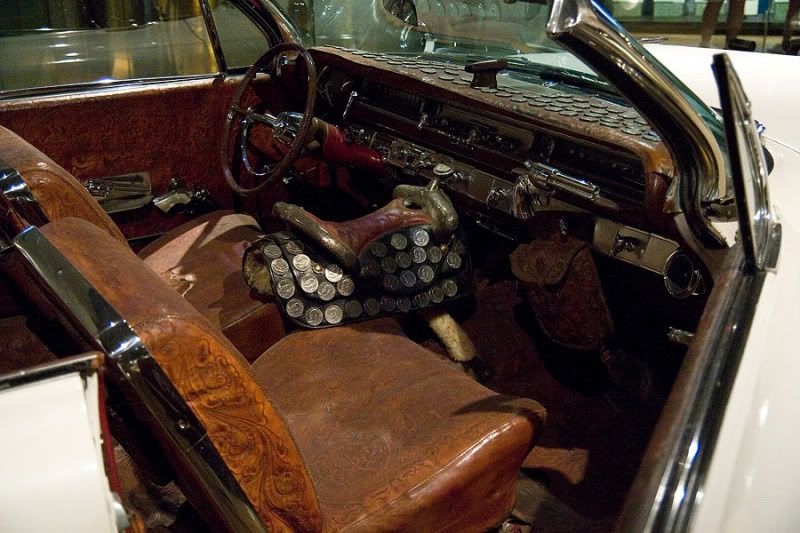
Webb Pierce's car pimped out by Nudie Cohen, the '62 Bonneville convertible.
-
Once heard not too long ago, that West point surpassed Fort Knox for the amount of gold stored.True?Not True?
May 19, 2009
United States, 8,965.6 Tons, $286.89 Billion. Perhaps the most famous gold depository in the world is the United States Bullion Depository in Fort Knox, Kentucky. It holds a majority of the US gold reserves, which are estimated by the US Mint to be approximately 147.3 million ounces, or approximately 4,603 tons. The United States' total gold reserves, 8,965.6 tons, are valued at approximately $286.89 billion. The remainder of the US reserves are held at the Philadelphia Mint, the Denver Mint, the West Point Bullion Depository and the San Francisco Assay Office.
http://www.socyberty.com/Economics/Worlds-Largest-Gold-Reserves.716893
-
Been over a year, any changes to this post?
-
In my mind, I’m trying to analyze how a gold coin made in the 1900’s, bagged and stored in a vault/vaults for 60 years can be graded out as MS-69, or even grade out at MS-68 (the key word here is “bagged“ and maybe even re-bagged…as in tumbling, scraping, rubbing, clinking, digging and chinking)
Seems to me the handling alone would render even the best of the best to no more than a 66.
-
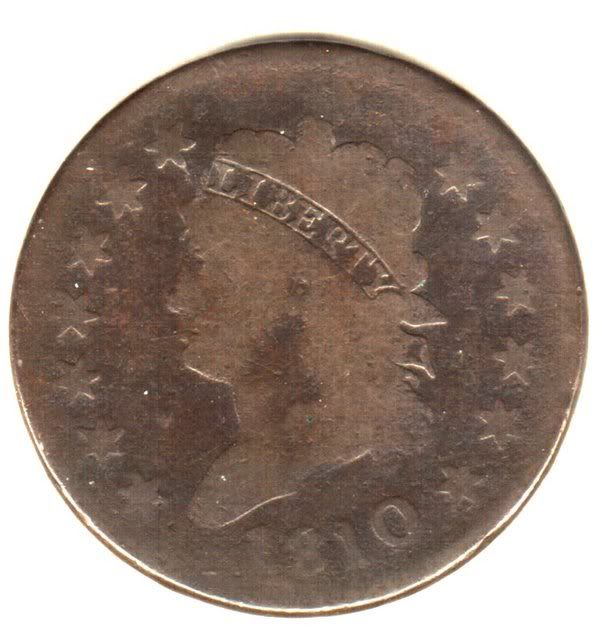
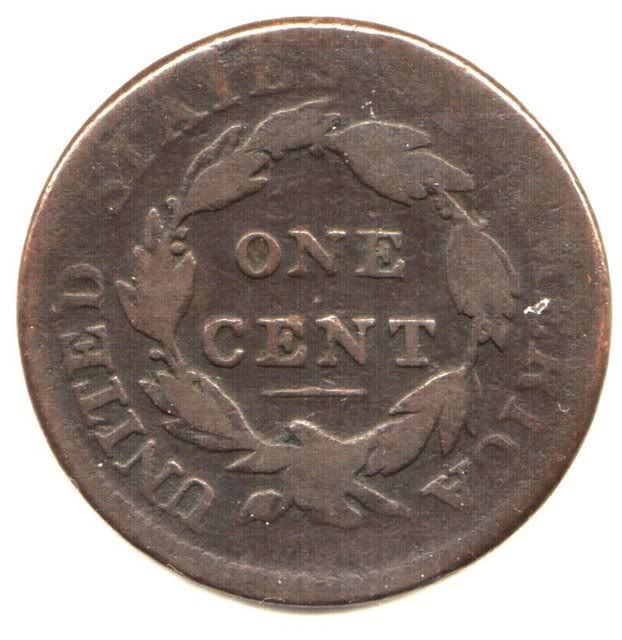
Fun coin for $30 bought off e-bay with lousy seller images.
You do not need to spend an arm and a leg to get your hands on some fun coins (especially between large purchases) these days, this is an 1810 Classic Head that still has some definition left in the devices. What was fun with this coin, it turned out to be an 1810/09 Although faint due to wear, in hand under 10X magnification, you can still make out the 0 under the 1 and the tail of the 9 below the 0 in 10.
I was glad to see some dentils still remaining on the reverse and a portion Miss Liberty’s ear still visible.
I would grade the 198 year old chocolate brown copper as between G-4 and G-8 or a G-6. I did not notice any EV damage just good honest wear, the images have been lightened to show detail.
Have fun! Explore! They don't all have to be diamonds, grab a handful of gravel and take a chance...you might be surprised.
-
~The Reverse is pristine except for this thin curved line of black material that runs from 5:30 to 9:00. The light has to be on the coin in just the right way or you're not really going to notice it.~
I have a 1941-P Walker that has faint black lines running along a few of the rays on the obverse sun burst. I have no idea what this black stuff is other than it looks like carbon, but that makes no sense?
Nice looking Walker though, that's what you call a "blazer"
-

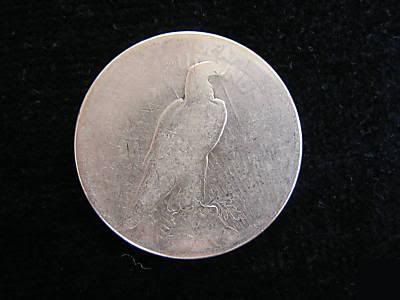
1934 Peace Dollar (sellers pics) bought for $15 to be used again as a novelty pocket piece.
-
Coin, this statement is interesting: as I am aware of at least one in the NGC CENSUS listed as 1967 SMS 5C 6FS .
I was not aware of this, more information on this coin would be of interest.
Hoot, glad to see you respond to this query also, your knowledge of nickels is indispensable and I am in compliance with your analogy on the quality of the Jefferson nickels that came out of this SMS era.
Once again, we see different terminology between the grading services, where is the conformity?
Maybe the TPG need to have a conference/summit hosted by the ANA to get everyone on the same page so the collectors don’t have to sit around and figure this stuff out on their own.
Maybe it’s the prime reason for a chat board, to interact on our own so they don’t have to?
-
With introduction of the satin finish Mint Sets in 2005, Monticello was replaced by the Bison.
-
The 1994 250th Jefferson Anniversay Matte Finish is designated SP by NGC and 99.9% have full steps and is not recognized.
PCGS calls the 1994 Matte Proofs SMS and does designate FS on those coins.
PCGS calls the 1997 Botanical Gardens Matte Proof SMS and also designates FS on these coins.
NGC again refers to the 1997 Matte Finish as SP without a designation, while 99.99% of these having Full Steps.
ANACS refers to the 1997 Matte Finish as MS (Mint State) for the numerical grade and indicates the number of visible steps.
(in other words, NGC takes for granted that these two moderns are basically minted with full steps and there is no reason for the designation, I agree)
-
I fully understand the “proof” part in the theory but proof coinage is struck twice, SMS coins were only struck once, albeit on a higher tonnage press.
Proof coins were struck with highly polished dies, SMS coins were struck with polished dies but they were not changed out with the same frequency as the proof dies.
Proof coins were struck on polished planchets, the SMS coins were struck on specially burnished planchets, just one step up from traditional business struck coins.
Proof coins were individually handled, and although Eva Adams the then Mint Director said the coins would be handled the same, Rick Tomaska says they were not. He says quantities were dumped into bins. "Individual handling" might have involved nothing more than the sorting of coins into compartments in packaging.
Adams promised in her 1966 report: "They will have a higher relief than regular coins and be better in appearance than any of the regular uncirculated sets heretofore issued."
I have seen many nice coins come out of SMS but as far as the Jefferson nickels that have well defined steps, well, that’s a whole other story.
Not arguing, just pointing out various differences.
-
Since the top grading services recognize the ‘65, ‘66 & ‘67 Special Mint Set series as MS when considering numerical grades, why aren’t the steps on these SMS Jefferson’s taken into consideration for the FS (Full Step) designation also?
Could it be that they just don’t exist, those with full steps that is, or is there another reason?
-
Both coins are graded by PCGS so alas ...... no stars. The dime is not 67 fb

The finest Uncirculated non-Full Bands examples graded by PCGS are 2 MS-68s.
The finest Uncirculated Full Bands examples graded by PCGS are 10 MS-69's!

 hm
hm 
-
I'm not touching the gold, but the '39-D Mercury dime is a MS-67FB stunner!
-
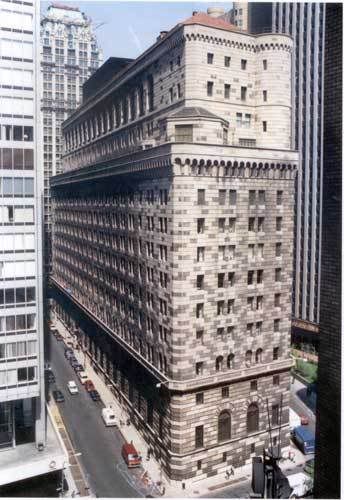
Federal Reserve Bank of New York Building
First used in 1924, the Federal Reserve Bank of New York took six years to build

Federal Reserve Bank of New York Entrance
The entrance to the Federal Reserve Bank of New York is located at 33 Liberty St
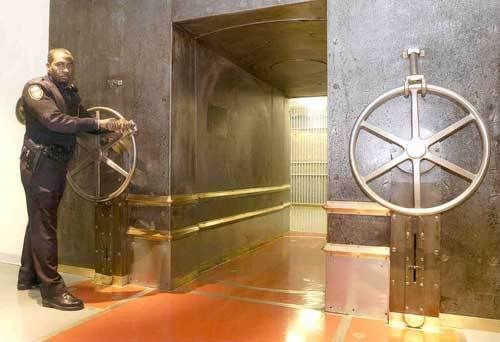
Entry to the Gold Vault
This ten-foot passageway is cut through a 90-ton steel cylinder

Gold Bars in the Gold Vault of the Federal Reserve Bank of New York
The gold vault at the Federal Reserve Bank of New York is built directly on Manhattan's bedrock to be able to support the enormous weight of the gold.

Gold Bars are held in 122 compartments in the main and auxillary vaults
Each gold bar weighs about 27.4 pounds and is worth about $400,000
The Federal Reserve Bank of New York maintains a vault that lies 86 feet below sea level, resting on Manhattan bedrock. By 1927, the vault contained ten percent of the world's official gold reserves. Currently, it is reputedly the largest gold repository in the world (though this cannot be confirmed as Swiss Banks do not report their gold stocks) and holds approx 5,000 metric tons of gold bullion ($160 billion as of March, 2008), more than Fort Knox. The gold is owned by many foreign nations, central banks and international organizations. The Federal Reserve Bank does not own the gold but serves as guardian of the precious metal, which it "protects" at no charge as a gesture of good will to other nations. Free tours of the vault are available to the public.
note: Members of three separate bank departments are required to enter the vaults and to move gold bars.
-
In 1962 (I assume it is '62) looks like about a 6:1 ratio between the Mercury dimes and the Roosevelts...in other words for every 6 Roosies there was still 1 Mercury dime left in circulation.
Sounds about right....even if my memory fails me, there were still lots of Walkers and Mercury dimes and an occasional Buffalo nickel still to be gotten in change back then.
I had my Mom give me my March of Dimes card (50 years later) that I had about half filled out and never turned in, I have it somewhere, but they were all Roosies (circa 1957)
-
On page 209 it gives the definition for "numismatics" take a look at the very next word!
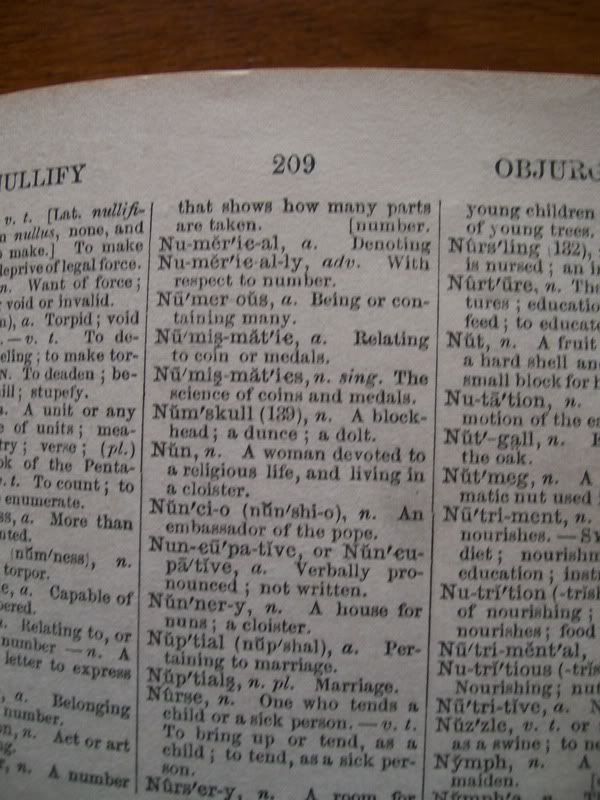
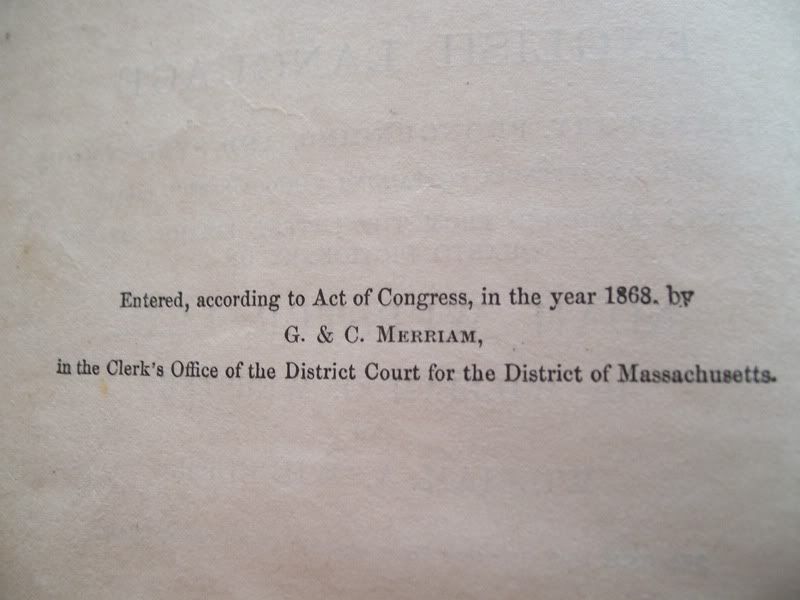

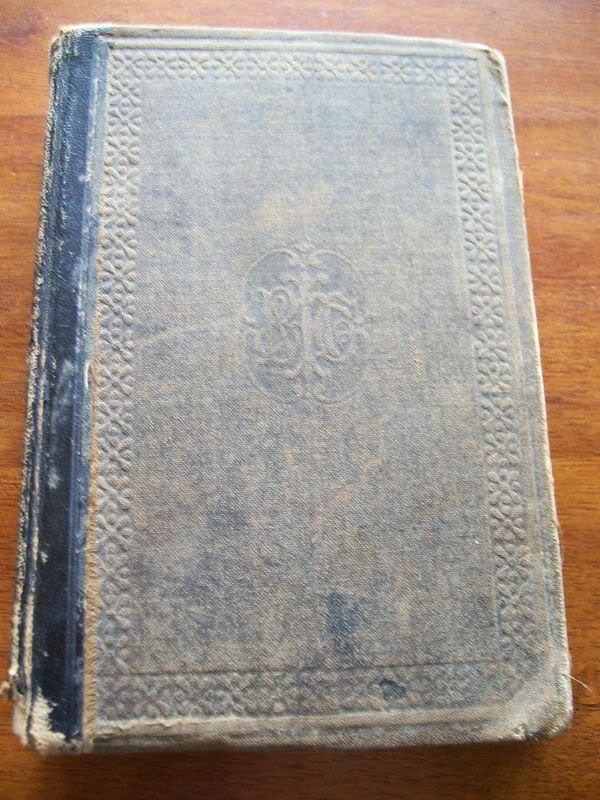
-
Dateline, New, New York
Auto-Grader® proto-type discovered.
Today a maintenance man working in the lower levels of the recently demolished Empire State Building, unearthed a cache of old style paper backed photo’s. In the numerous stacks of old photos was the discovery of the proto-type of the highly acclaimed, Auto-Grader®. The highly recognized and successful Auto-Grader® is now in use world wide by most every coin collector on the planet.
This extraordinary find confirms that indeed a splinter group did break away from the combined grading service to form the notion that in the near future, there will be a “coin grader in every home”
Some of the detailed plans recovered included a brief summation of how the Auto-Grader® takes the inserted coin through several stages, to finally emerge at the end, fully graded and inside the now very recognizable Glucite slab.
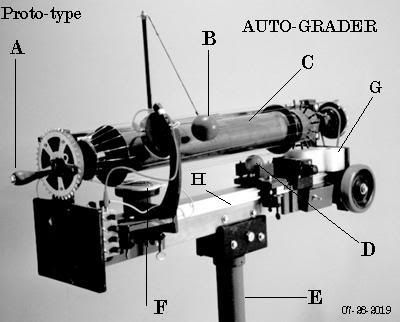
A. Hand crank
B. Static Compensator
C. Drum
D. Coin Chamber
E. Stand
F. Calibrator
G. Glucite injectors
H. Traverse Bar
D. Insert coin, token, chit into chamber with what ever side to be viewed first, facing out. Latch chamber closed.
Note: at this time, ensure tab printer is full of inserts, also have the injection molder pre-heated and full of plasticized pellets
A. Turn crank clockwise no faster than 60 RPM
C. As the collating drum revolves, the calibrator travels towards the coin drum, resets as the coin chamber flips to read the opposite side. When the calibrator is returned to the Home Position, your finalized coin will drop from the feeder rollers, directly onto a cooling tray.
-
Coin Slabbing of the Future
In the future, there will be only one combined grading service, PNGCS. This conglomerate will operate as one entity for the entire hobby of Numismatics. As of 07/01/2021 no other agency will be allowed to start up or combine with the Mother Ship after this cut-off date.
In addition to the regular grading skills, all future Graders will have E.S.P. capabilities . While they are holding the coin, the grader will see flashes of who actually handled that particular coin in the past. These extra sense abilities will immediately inform the grader if a coin is a counterfeit, has been doctored, or altered in any way and by WHOM!
Ports installed into the graders cerebellum will allow downloads of images so further prosecution can be executed.
The cases will be made of clear diamond silica carbonate, fused together with .05 mega-watt lasers in a argon-xenon gas matrix vacuum. On the Moh’s harness scale, this new slab material is equivalent to a natural occurring corundum (ruby) impervious to the most of common means of entry.
Before sealing the coin into the slab, a programmable digital electronic microprocessor was imbedded in the carbonate, pre-set to a determined frequency. This microprocessor will emit a frequency signal of between 900-1600 megahertz, the same as most modern day cell phones, so in essence, the slab is constantly calling up the Grading Service and asking a verifier for authenticity.
If the verifier determines that the slab or the coin contained is not the original as issued, the verifier will send out a mobile Tracking Goon Squad to collect the errant coin slab.
This Squad has at it’s disposal, all the means necessary to retrieve the grading services proxy property. Think of men dressed in all black, head gear, batons, boots, guns, battering rams...ahh kinda like present day SWAT Teams going in after a known felon. "We have a no-knock warrant from PNGCS!" BOOM!
Profiteers who wish to emulate the grading services will have a tough time, as the next generation f-bay and other auction venues will install screening devices to prohibit falsified/generic coin slabs.
Raw coin dealers will proliferate in the alleys and back rooms of abandoned pool halls and other dark seedy places. These RawC’s as they will become to be known, will still grace the outlawed Dansco albums that so many collectors now hide from the authorities.
The future is great…or is it?
- EmiCoins and EleMint Man
-
 2
2
-
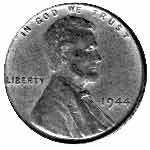
1944 examples do exsist and in the description of this coin, it noted foreign planchets at US Mints during this era. As TomB notated about the possibility of a foreign palnchet, the one you have is probably one of the first two scenerios. I just wanted to add this at an approriate time that nothing is impossible.
This MS-60 (there are probably less than five mint state pieces known to exist) 1944 steel cent is noted on the holder as "Struck on Steel Planchet" rather than "Struck on 1943 Steel Planchet" because there is a possibility that the blank came from a 1944 Belgian 2-Francs coin. The US Mint was under contract to produce 2-Francs pieces for Belgium in that year, and the composition and weight of the planchets is indistinguishable from the 1943 "steelies."
-
robec, that's like going from a older Motel6 to a brand new Double Tree!
I still like them both...do not get rid of the honest wear Jefferson though, those old coins have character to them.
-
Cool story, Woody, but I know why you couldn't locate the jar. A week after you buried it, your brother went back and got the cash.

Chris



 dirtyfrickenrickenracken
dirtyfrickenrickenracken 

-
It may not have been dumb, but planning was not exactly our forte'
In 1955 my Bother and I along with a neighborhood friend of ours buried a "time capsule" in our homestead backyard. We assembled a cent, nickel, dime and believe it or not, a whole quarter to bury. (Mind you, a quarter at that time could buy 25 pieces of candy or 5 packs of baseball cards, so in our eyes, this was a huge investment) The empty Kraft mayonnaise jar was cleaned, a note stating our intentions was drafted on 3 line paper with a sharpened #2 pencil. We all signed it and sealed the contents into the jar. We had my Mom melt some paraffin wax used for canning and had her turn the jar upside down and dip the metal lid a few times.
Looking around for a suitable spot, we selected an area in the backyard just like a pirate would go through. 10 kid paces from the maple tree, by 10 kid paces from the corner of the one car garage. Bingo, X marks the spot. We dug down about 2' and buried the clinking jar with visions of digging the time capsule up years later.
Summers past, we all graduated from grade school and then on to high school where girls finally replaced pirate expeditions and tree climbing.
It wasn't until years later while looking up through the canopy of the night time jungle that it came to mind about the time capsule. I made a mental note that once I returned to the States that I would assemble the gang and we would proceed to resurrect the once buried treasure.
When I finally got back to my childhood home, I immediate realized there had been some changes. The one car garage had been torn down and a new 2 car garage on a concrete slab had been erected. The maple tree was also gone, either to make way for the garage or it had died and was cut down. I asked my Dad about all the changes while I was gone and he concurred about the maple tree being cut down so the roots would not crack and heave the new concrete slab.
Disappointment quickly set in and I asked him about the construction of the slab. He said the contractors only dug below the frost line (less than 14") laid down sand, compacted and then poured the concrete into the rebar form. I knew the capsule had not been disturbed by erecting the garage, but without the tree, there was no way of determining the exact location. I even went back years later with a metal detector and checked the general area, but only found an old trash burning pit.
To this day, there are 4 coins from 1955 buried somewhere in my parents backyard. I often wondered about the cent...would it survive...did we bury a doubled die variety? Would the other coins tone due to being confined with a sheet of that old hand writing paper? I guess I’ll never find out, perhaps in the next millennia, someone dressed in a “finders suit” will come across some 200 year old coins buried in a unidentified substance container.

-
I read somewhere way back when, that Hofmann used a technique called "explosive impact copying" to produce a large quantity 1916-D Standing Liberty Quarters. Shooting a cast hub into annealed dies through a .12 gauge shot gun seemed to fool even the best of examinations. Perhaps that is how this cent came about...a mint produced planchet, two homemade shot gun dies...waa laa, one 1959 Lincoln cent with a wheat reverse.
I would think you would not want to be in the same room when pulling the trigger on the shotgun.





PCGS vs NGC PF70 Prices
in US, World, and Ancient Coins
Posted
"Kool-Aid" drinkers (surrounded up masses of collectors who have been brain washed into thinking PCGS is by far superior to any other grading company) like robots, line up at dealer tables like lemmings and purchase gradeflated/overpriced slab after slab of PCGS entombed coins.
Realistic collectors in most instances, often revert back to the old mantra, "Buy the coin, not the slab."
When it comes to coins, both NGC and PCGS are the trade marks of excellence.
I'm not as subtle as Mark.